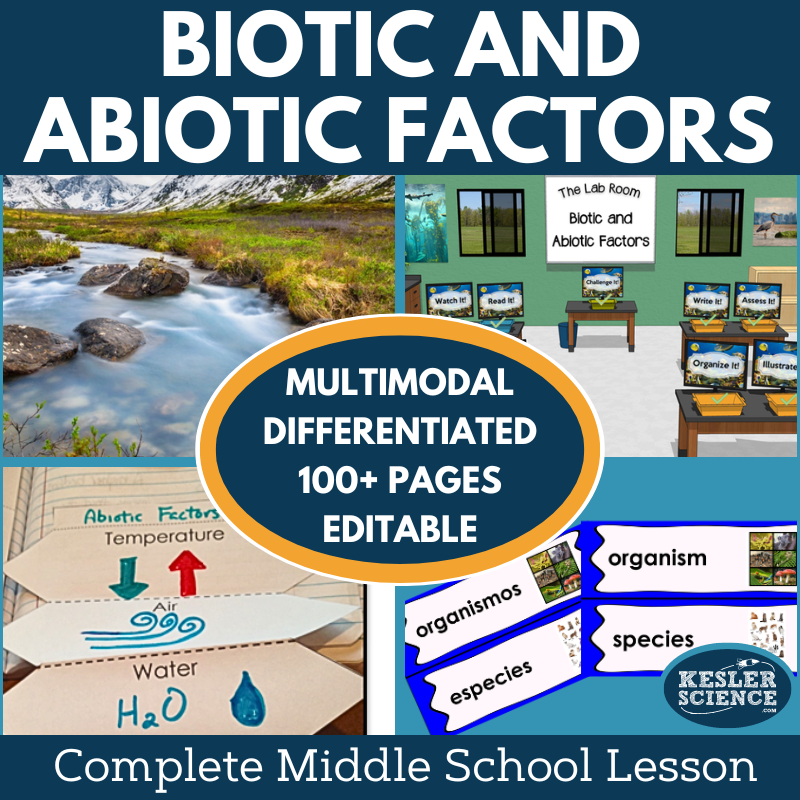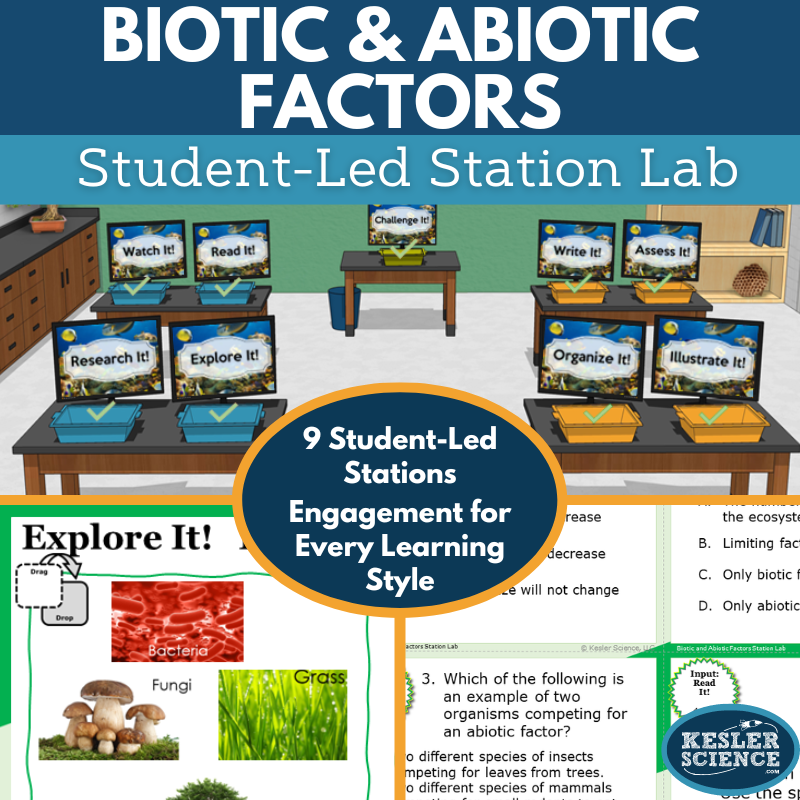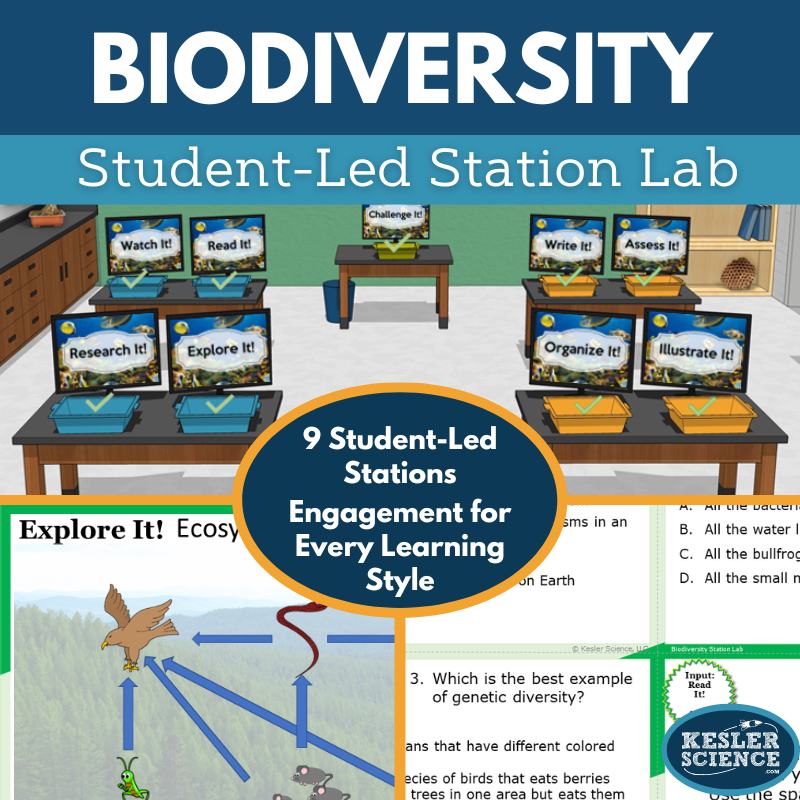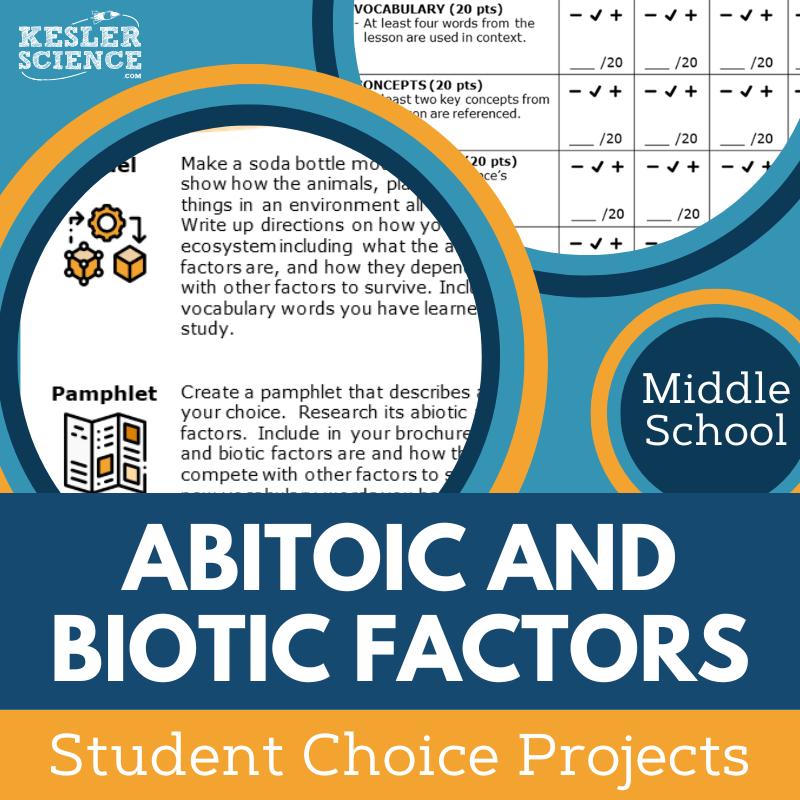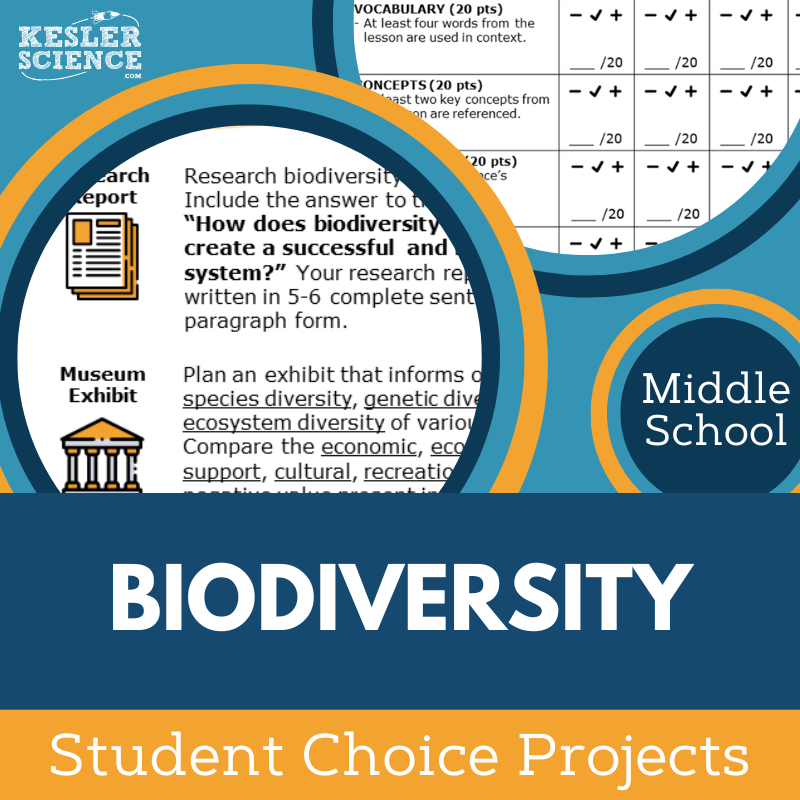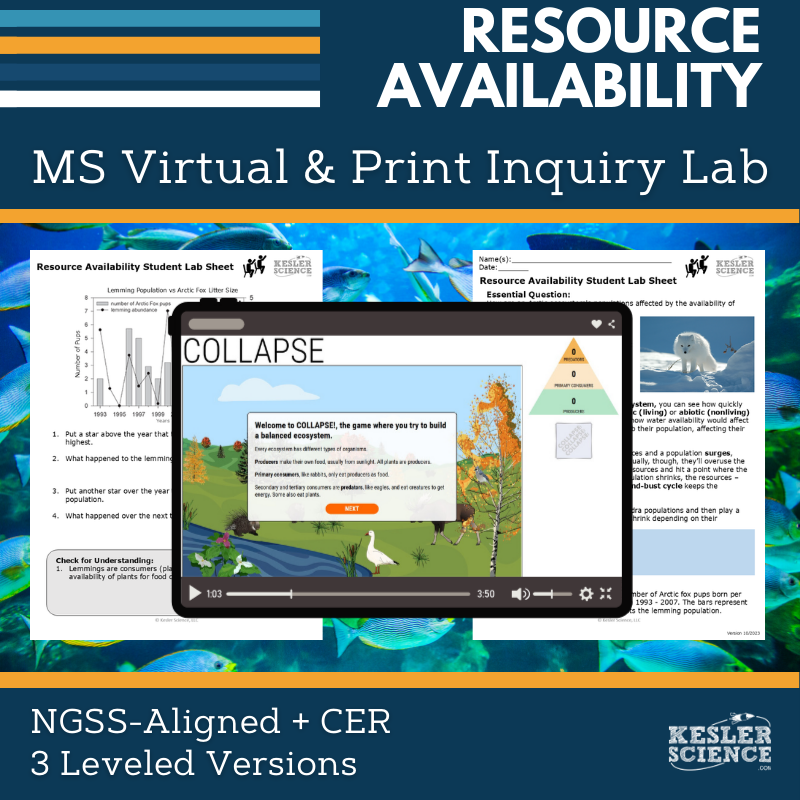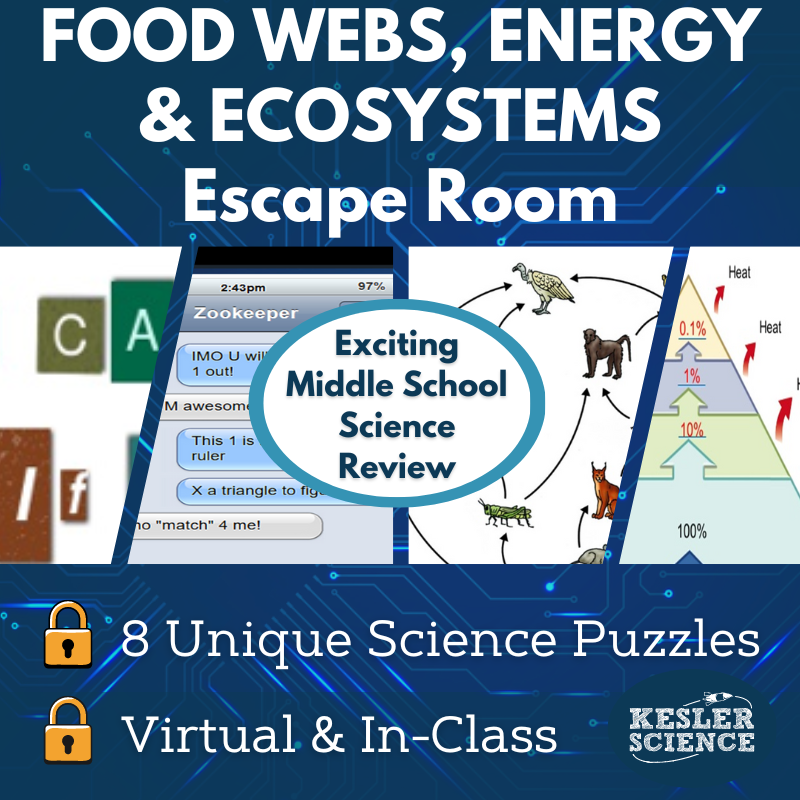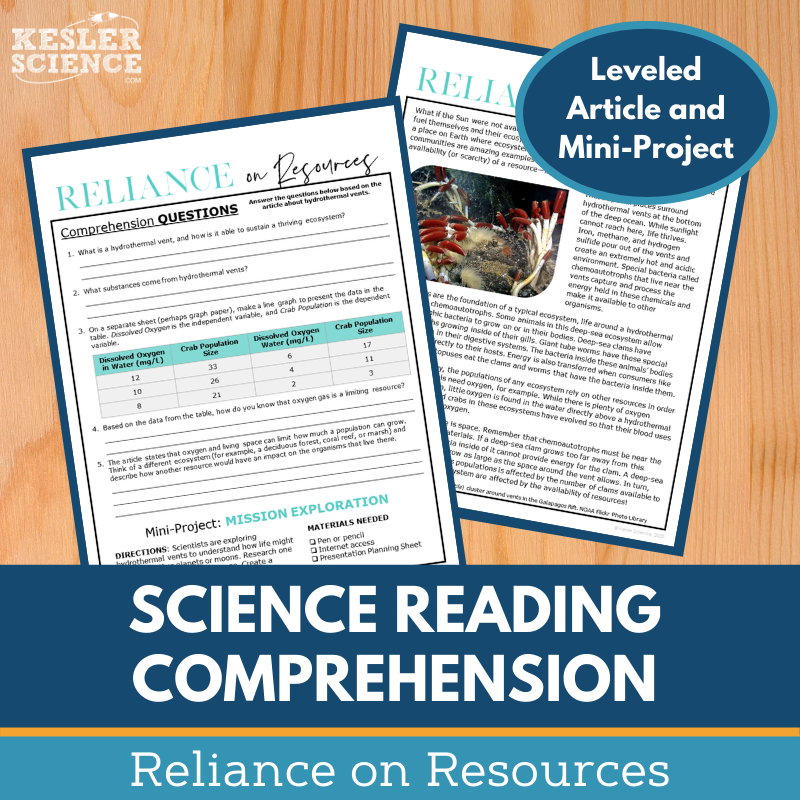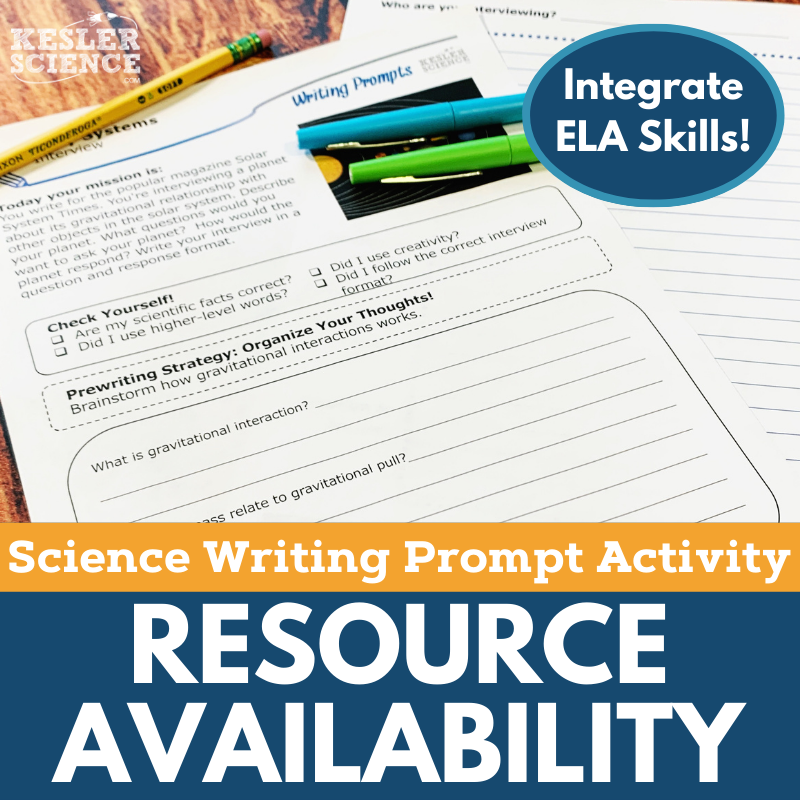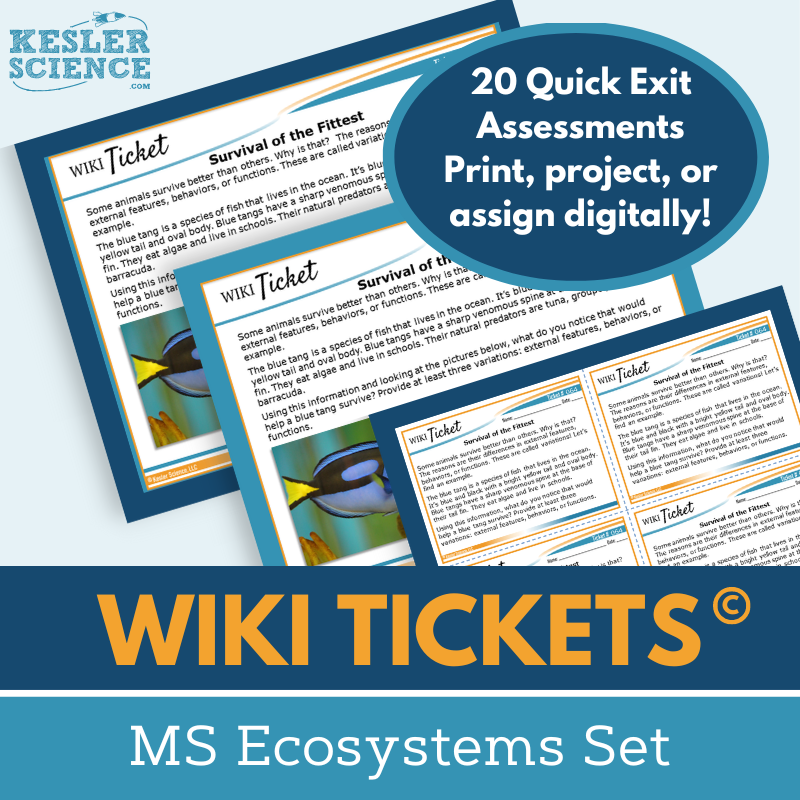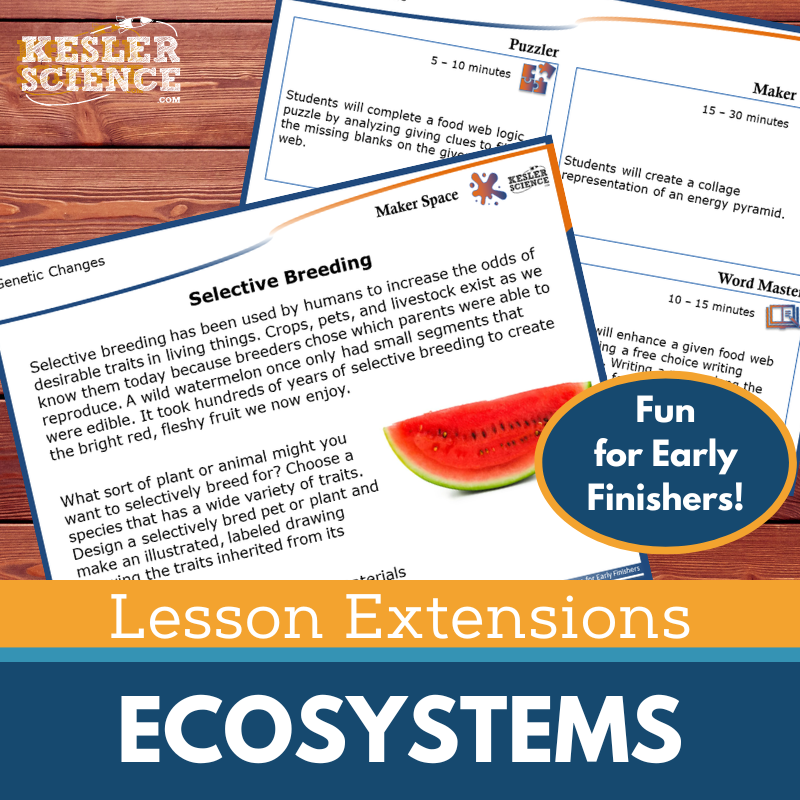Resource Availability Activities for Middle School Science
The Kesler Science Biotic and Abiotic Factors and Biodiversity 5E Lessons engage middle school students in exploring how organisms interact with their environment and how biodiversity supports ecosystem sustainability using the 5E model. The resources below will give students a comprehensive understanding of resource availability. All of the following materials are also included in the Kesler Science Membership.
The Kesler Science Biotic and Abiotic Factors 5E Lesson provides an engaging and comprehensive middle school science unit aligned with NGSS standards. It uses the research-based 5E model—Engagement, Exploration, Explanation, Elaboration, and Evaluation—to explore how organisms depend on and compete for biotic and abiotic factors in ecosystems.
This student-led lesson includes differentiated and multimodal materials such as editable PowerPoints, interactive notebooks, worksheets, choice projects, and assessments to meet diverse learner needs. In the Exploration phase, students engage in a differentiated station lab with hands-on experiments, readings, research, videos, and interactive tasks to deepen their understanding. The lesson also supports bilingual learners with resources available in both English and Spanish.
Flexible formatting allows for easy adaptation for classroom or virtual use, requiring minimal preparation. Additionally, students extend their learning through choice projects, while assessments aligned with STAAR 2.0 standards effectively evaluate student mastery.
The Kesler Science Biotic and Abiotic Factors 5E Lesson provides an engaging and comprehensive middle school science unit aligned with NGSS standards. It uses the research-based 5E model—Engagement, Exploration, Explanation, Elaboration, and Evaluation—to explore how organisms depend on and compete for biotic and abiotic factors in ecosystems.
This student-led lesson includes differentiated and multimodal materials such as editable PowerPoints, interactive notebooks, worksheets, choice projects, and assessments to meet diverse learner needs. In the Exploration phase, students engage in a differentiated station lab with hands-on experiments, readings, research, videos, and interactive tasks to deepen their understanding. The lesson also supports bilingual learners with resources available in both English and Spanish.
Flexible formatting allows for easy adaptation for classroom or virtual use, requiring minimal preparation. Additionally, students extend their learning through choice projects, while assessments aligned with STAAR 2.0 standards effectively evaluate student mastery.
The Kesler Science Biodiversity 5E Lesson is a comprehensive, student-led unit designed for middle school, aligned with NGSS and TEKS. It includes editable presentations, worksheets, choice projects, and assessments, requiring minimal prep while supporting differentiated learning. The lesson explores how biodiversity contributes to ecosystem sustainability through multimodal and flexible formats, including printable and digital options. Spanish translations are available for key materials.
The 5E Model structure provides engaging content for each phase. In Engagement, students discuss key concepts using word wall cards and class activities. The Exploration phase features a differentiated station lab with nine stations, including hands-on experiments, reading passages in English and Spanish, research tasks, videos, and interactive activities. Explanation includes editable PowerPoints, interactive notebooks, and note-taking templates. For Elaboration, student-choice projects deepen understanding. Evaluation consists of updated STAAR 2.0-aligned assessments and review worksheets.
Designed for both in-class and virtual learning, this lesson ensures accessibility and engagement through student-centered activities, allowing teachers to focus on student success.
The Kesler Science Biodiversity 5E Lesson is a comprehensive, student-led unit designed for middle school, aligned with NGSS and TEKS. It includes editable presentations, worksheets, choice projects, and assessments, requiring minimal prep while supporting differentiated learning. The lesson explores how biodiversity contributes to ecosystem sustainability through multimodal and flexible formats, including printable and digital options. Spanish translations are available for key materials.
The 5E Model structure provides engaging content for each phase. In Engagement, students discuss key concepts using word wall cards and class activities. The Exploration phase features a differentiated station lab with nine stations, including hands-on experiments, reading passages in English and Spanish, research tasks, videos, and interactive activities. Explanation includes editable PowerPoints, interactive notebooks, and note-taking templates. For Elaboration, student-choice projects deepen understanding. Evaluation consists of updated STAAR 2.0-aligned assessments and review worksheets.
Designed for both in-class and virtual learning, this lesson ensures accessibility and engagement through student-centered activities, allowing teachers to focus on student success.
Engage your middle school students with this modular, student-led station lab aligned with NGSS standards, exploring biotic and abiotic factors in ecosystems. Students independently identify, compare, and apply concepts through nine differentiated stations featuring multimodal activities such as hands-on tasks, interactive research, reading passages in English and Spanish, and videos.
Input stations like Explore It!, Research It!, Read It!, and Watch It! introduce foundational concepts through interactive tasks, digital manipulation of images and text, and guided readings. Output stations, including Organize It!, Illustrate It!, Write It!, and Assess It!, allow students to demonstrate understanding through models, writing, manipulatives, and assessments. An additional Challenge It! station provides extension activities such as crosswords, games, and mini-projects for early finishers.
Designed for both classroom and virtual settings, this student-centered resource promotes personalized learning, active engagement, and critical thinking.
Engage your middle school students with this modular, student-led station lab aligned with NGSS standards, exploring biotic and abiotic factors in ecosystems. Students independently identify, compare, and apply concepts through nine differentiated stations featuring multimodal activities such as hands-on tasks, interactive research, reading passages in English and Spanish, and videos.
Input stations like Explore It!, Research It!, Read It!, and Watch It! introduce foundational concepts through interactive tasks, digital manipulation of images and text, and guided readings. Output stations, including Organize It!, Illustrate It!, Write It!, and Assess It!, allow students to demonstrate understanding through models, writing, manipulatives, and assessments. An additional Challenge It! station provides extension activities such as crosswords, games, and mini-projects for early finishers.
Designed for both classroom and virtual settings, this student-centered resource promotes personalized learning, active engagement, and critical thinking.
Engage your middle school students in an interactive, student-led exploration of biodiversity with this station lab. Designed to promote independent learning, this low-prep resource allows students to identify and compare characteristics of biodiversity through nine hands-on and digital activities.
Students encounter new concepts through multimodal input stations, including hands-on demonstrations, research tasks, reading passages in English and Spanish, and video analysis. Output stations challenge students to organize information, illustrate models, write responses, and complete assessments. A bonus challenge station offers extension activities like crosswords, games, and mini projects for early finishers.
This versatile resource includes all necessary signage, task cards, and digital options for virtual learning, making it an adaptable and engaging addition to any middle school science curriculum.
Engage your middle school students in an interactive, student-led exploration of biodiversity with this station lab. Designed to promote independent learning, this low-prep resource allows students to identify and compare characteristics of biodiversity through nine hands-on and digital activities.
Students encounter new concepts through multimodal input stations, including hands-on demonstrations, research tasks, reading passages in English and Spanish, and video analysis. Output stations challenge students to organize information, illustrate models, write responses, and complete assessments. A bonus challenge station offers extension activities like crosswords, games, and mini projects for early finishers.
This versatile resource includes all necessary signage, task cards, and digital options for virtual learning, making it an adaptable and engaging addition to any middle school science curriculum.
This Biotic and Abiotic Factors Student Choice Projects lesson aligns with NGSS science standards, enabling middle school students to select a project matching their preferred style. A project page offers nine student-led options plus a “design your own” choice, supported by an editable rubric for teacher, peer, or self-assessment.
The projects are flexible, dynamic, and multimodal, allowing students creative ways to demonstrate understanding. Two versions of the project page provide differentiation—one includes modified options for remediation, while challenge opportunities are available through combinations of projects. The rubric assesses vocabulary, concepts, presentation, clarity, and accuracy, and teachers can adjust it to their grading needs.
Projects require common classroom materials such as paper, markers, and scissors, and many can be completed digitally. Some crafting supplies may be helpful for building models.
This Biotic and Abiotic Factors Student Choice Projects lesson aligns with NGSS science standards, enabling middle school students to select a project matching their preferred style. A project page offers nine student-led options plus a “design your own” choice, supported by an editable rubric for teacher, peer, or self-assessment.
The projects are flexible, dynamic, and multimodal, allowing students creative ways to demonstrate understanding. Two versions of the project page provide differentiation—one includes modified options for remediation, while challenge opportunities are available through combinations of projects. The rubric assesses vocabulary, concepts, presentation, clarity, and accuracy, and teachers can adjust it to their grading needs.
Projects require common classroom materials such as paper, markers, and scissors, and many can be completed digitally. Some crafting supplies may be helpful for building models.
This Biodiversity Student Choice Projects lesson allows middle school students to demonstrate their understanding in a way that suits their learning style. A project page outlines six student-led options along with a “design your own” project, offering a range of creative and engaging ways to explore biodiversity concepts. An editable rubric provides flexibility for teacher, peer, or self-assessment, ensuring clear evaluation criteria.
These projects are designed to be adaptable and accessible for all learners. Two versions of the project page support differentiation, with modified options for students who need remediation and challenge opportunities for advanced learners. Teachers can mix and match projects while using the same rubric, making it easy to customize instruction and assessment. The multimodal approach encourages critical thinking and creativity, allowing students to showcase their knowledge in unique ways.
Minimal materials are required, as most projects can be completed using standard classroom supplies such as paper, markers, and scissors. Many options also allow for digital completion, making the projects versatile for different learning environments. Whether students prefer hands-on activities, digital presentations, or artistic expressions, this lesson provides meaningful opportunities for engagement and deeper understanding of biodiversity.
This Biodiversity Student Choice Projects lesson allows middle school students to demonstrate their understanding in a way that suits their learning style. A project page outlines six student-led options along with a “design your own” project, offering a range of creative and engaging ways to explore biodiversity concepts. An editable rubric provides flexibility for teacher, peer, or self-assessment, ensuring clear evaluation criteria.
These projects are designed to be adaptable and accessible for all learners. Two versions of the project page support differentiation, with modified options for students who need remediation and challenge opportunities for advanced learners. Teachers can mix and match projects while using the same rubric, making it easy to customize instruction and assessment. The multimodal approach encourages critical thinking and creativity, allowing students to showcase their knowledge in unique ways.
Minimal materials are required, as most projects can be completed using standard classroom supplies such as paper, markers, and scissors. Many options also allow for digital completion, making the projects versatile for different learning environments. Whether students prefer hands-on activities, digital presentations, or artistic expressions, this lesson provides meaningful opportunities for engagement and deeper understanding of biodiversity.
The Resource Availability Inquiry Lab aligns with the NGSS MS-LS2-1 standard, guiding students to analyze data and explore how resource availability affects populations in ecosystems. This lab offers flexibility through both interactive digital and hands-on print formats, each including comprehension questions, Claim-Evidence-Reasoning (C.E.R.) prompts, and reflective activities.
Differentiation is built-in with three versions (dependent, modified, independent), accommodating varying student needs through structured guidance, inquiry prompts, or student-led exploration. Students engage in analyzing tundra population graphs and participate in a resource-based ecosystem game to understand population dynamics.
The print version provides a tangible classroom experience, requiring ecosystem cards, tally sheets, dice, and optional Internet access for advanced learners. The digital format offers a fully interactive PowerPoint experience compatible with Google Slides and LMS platforms such as MS Teams, Schoology, and Canvas. It includes virtual gameplay and interactive components to sustain student engagement without additional materials.
Both formats come with editable files, answer keys, teacher resource pages outlining objectives and standards, and detailed preparation guidance, enabling customization and straightforward implementation.
The Resource Availability Inquiry Lab aligns with the NGSS MS-LS2-1 standard, guiding students to analyze data and explore how resource availability affects populations in ecosystems. This lab offers flexibility through both interactive digital and hands-on print formats, each including comprehension questions, Claim-Evidence-Reasoning (C.E.R.) prompts, and reflective activities.
Differentiation is built-in with three versions (dependent, modified, independent), accommodating varying student needs through structured guidance, inquiry prompts, or student-led exploration. Students engage in analyzing tundra population graphs and participate in a resource-based ecosystem game to understand population dynamics.
The print version provides a tangible classroom experience, requiring ecosystem cards, tally sheets, dice, and optional Internet access for advanced learners. The digital format offers a fully interactive PowerPoint experience compatible with Google Slides and LMS platforms such as MS Teams, Schoology, and Canvas. It includes virtual gameplay and interactive components to sustain student engagement without additional materials.
Both formats come with editable files, answer keys, teacher resource pages outlining objectives and standards, and detailed preparation guidance, enabling customization and straightforward implementation.
The Food Webs, Energy, and Ecosystems Escape Room is an interactive, engaging activity that helps students demonstrate their understanding of food webs, food chains, and energy transfer within ecosystems. Aligned with TEKS and NGSS standards, it challenges students to explore the flow of energy, including the role of photosynthesis and the effects of ecosystem changes on populations.
Teachers have full control over the eight independent puzzles, allowing customization based on class time. The room can be set up with manila envelopes for a simple experience or a more authentic setup with locks and a storage box. Materials include printed resources, envelopes, rulers, and optional plastic animals.
For online use, a digital version is available in PowerPoint format for assignment via email or Google Slides. Students can also complete the activity at home with a printable version.
The resource includes teacher directions, detailed answer keys, editable templates, and over 50 prize ideas. With a video challenge to set the mood and unique puzzles, students will stay immersed in this fun, standards-aligned learning experience.
The Food Webs, Energy, and Ecosystems Escape Room is an interactive, engaging activity that helps students demonstrate their understanding of food webs, food chains, and energy transfer within ecosystems. Aligned with TEKS and NGSS standards, it challenges students to explore the flow of energy, including the role of photosynthesis and the effects of ecosystem changes on populations.
Teachers have full control over the eight independent puzzles, allowing customization based on class time. The room can be set up with manila envelopes for a simple experience or a more authentic setup with locks and a storage box. Materials include printed resources, envelopes, rulers, and optional plastic animals.
For online use, a digital version is available in PowerPoint format for assignment via email or Google Slides. Students can also complete the activity at home with a printable version.
The resource includes teacher directions, detailed answer keys, editable templates, and over 50 prize ideas. With a video challenge to set the mood and unique puzzles, students will stay immersed in this fun, standards-aligned learning experience.
In this engaging lesson, students explore how resource availability affects organisms and populations within ecosystems by reading a nonfiction article about hydrothermal ecosystems. Designed for middle school students (grades 6-8, and advanced 5th graders), the resource includes two leveled science articles (Lexile 1100-1300), each accompanied by five to seven comprehension questions and an interactive mini-project where students research and create a presentation on a scientific mission of their choice. The lesson also includes a Cornell notes template and visually engaging graphics suitable for both color and grayscale printing.
Ideal for classroom discussions, building science literacy, and enhancing textual analysis skills, this resource works well for in-person instruction, virtual learning, sub plans, ISS, extra credit, or supporting absent students. Files are compatible with popular digital platforms, including Google Classroom, MS Teams, Schoology, and Canvas, allowing students to complete assignments directly within a digital document (PPT or Google Slides).
In this engaging lesson, students explore how resource availability affects organisms and populations within ecosystems by reading a nonfiction article about hydrothermal ecosystems. Designed for middle school students (grades 6-8, and advanced 5th graders), the resource includes two leveled science articles (Lexile 1100-1300), each accompanied by five to seven comprehension questions and an interactive mini-project where students research and create a presentation on a scientific mission of their choice. The lesson also includes a Cornell notes template and visually engaging graphics suitable for both color and grayscale printing.
Ideal for classroom discussions, building science literacy, and enhancing textual analysis skills, this resource works well for in-person instruction, virtual learning, sub plans, ISS, extra credit, or supporting absent students. Files are compatible with popular digital platforms, including Google Classroom, MS Teams, Schoology, and Canvas, allowing students to complete assignments directly within a digital document (PPT or Google Slides).
The Resource Availability Science Writing Prompt Activity engages middle school students in a creative "call to action" letter-writing exercise to reinforce their understanding of resource availability in ecosystems. Aligned with NGSS MS-LS2-1, this low-prep, student-centered activity encourages science reasoning and exploration, suitable for both classroom and virtual learning.
The resource includes teacher directions with an answer guide, project ideas, and rubrics; full-sized handouts featuring the prompt, student self-check, pre-writing strategies, and templates; half-sheet versions ideal for interactive notebooks; and a digital PowerPoint version compatible with Google Slides. It is versatile enough for cross-curricular use, pre-tests, student choice projects, differentiation, extra credit, make-up work, TELPAS samples, or enrichment activities. The final student products make excellent bulletin board displays or anthology collections.
The Resource Availability Science Writing Prompt Activity engages middle school students in a creative "call to action" letter-writing exercise to reinforce their understanding of resource availability in ecosystems. Aligned with NGSS MS-LS2-1, this low-prep, student-centered activity encourages science reasoning and exploration, suitable for both classroom and virtual learning.
The resource includes teacher directions with an answer guide, project ideas, and rubrics; full-sized handouts featuring the prompt, student self-check, pre-writing strategies, and templates; half-sheet versions ideal for interactive notebooks; and a digital PowerPoint version compatible with Google Slides. It is versatile enough for cross-curricular use, pre-tests, student choice projects, differentiation, extra credit, make-up work, TELPAS samples, or enrichment activities. The final student products make excellent bulletin board displays or anthology collections.
The Ecosystems WIKI Tickets© set provides engaging formative assessments designed for middle school science students to demonstrate their understanding of ecosystems topics aligned with NGSS and TEKS standards. The set includes 20 interactive assessments covering a range of topics, such as biodiversity, biotic and abiotic factors, ecological succession, food chains and webs, human impact on oceans, and natural selection. Each assessment offers five versatile formats: a full-screen version for classroom projection, three printable handouts (full, split, and quarter-page), and a digitally editable PowerPoint or Google Slides option suitable for in-class or virtual learning.
WIKI Tickets© ("What I Know Is") can effectively serve as exit tickets, bellringers, or quick formative checks. Whether projected, printed, or assigned digitally, these colorful assessments allow teachers to flexibly monitor student progress in a dynamic and engaging manner.
The Ecosystems WIKI Tickets© set provides engaging formative assessments designed for middle school science students to demonstrate their understanding of ecosystems topics aligned with NGSS and TEKS standards. The set includes 20 interactive assessments covering a range of topics, such as biodiversity, biotic and abiotic factors, ecological succession, food chains and webs, human impact on oceans, and natural selection. Each assessment offers five versatile formats: a full-screen version for classroom projection, three printable handouts (full, split, and quarter-page), and a digitally editable PowerPoint or Google Slides option suitable for in-class or virtual learning.
WIKI Tickets© ("What I Know Is") can effectively serve as exit tickets, bellringers, or quick formative checks. Whether projected, printed, or assigned digitally, these colorful assessments allow teachers to flexibly monitor student progress in a dynamic and engaging manner.
Lesson Extensions offer engaging, student-choice activities specifically designed to challenge early finishers and deepen their understanding of ecosystems aligned with NGSS and TEKS standards. These extensions provide rigorous yet enjoyable learning opportunities ideal for lesson wrap-ups, downtime during testing, or preventing distractions by keeping students actively engaged.
Each extension includes four interactive components: Puzzler for developing problem-solving skills, Maker Space for hands-on STEAM activities, Tech Connection for digital media demonstrations, and Word Master for creative writing exercises related to science. The resources come with teacher directions, answer keys, and both digital projection and print versions (full- and half-sheet sizes) for classroom flexibility.
This bundle covers diverse ecosystem topics, including biodiversity, biomes, biotic and abiotic factors, ecological succession, food webs, human impact, photosynthesis, resource availability, and many more, supporting high-level enrichment and independent learning.
Lesson Extensions offer engaging, student-choice activities specifically designed to challenge early finishers and deepen their understanding of ecosystems aligned with NGSS and TEKS standards. These extensions provide rigorous yet enjoyable learning opportunities ideal for lesson wrap-ups, downtime during testing, or preventing distractions by keeping students actively engaged.
Each extension includes four interactive components: Puzzler for developing problem-solving skills, Maker Space for hands-on STEAM activities, Tech Connection for digital media demonstrations, and Word Master for creative writing exercises related to science. The resources come with teacher directions, answer keys, and both digital projection and print versions (full- and half-sheet sizes) for classroom flexibility.
This bundle covers diverse ecosystem topics, including biodiversity, biomes, biotic and abiotic factors, ecological succession, food webs, human impact, photosynthesis, resource availability, and many more, supporting high-level enrichment and independent learning.
This Amazing Anchors Phenomenon Lesson introduces and reinforces the concept of resources in an ecosystem through a real-world connection to regenerative farming. It includes an introductory reading with comprehension and extension questions to prepare students for deeper learning, followed by an explanatory reading that breaks down the science behind resources in an ecosystem with additional reinforcement questions.
Aligned with NGSS standard MS LS2-1, this no-prep resource includes teacher directions, answer keys, projection slides, and both print and digital formats for Google Classroom and other LMS platforms. A differentiated version provides sentence starters to support student comprehension. Designed to bookend a lesson, these engaging readings serve as supplements for the Engagement and Elaborate segments of 5E lessons in any in-person or virtual classroom.
This Amazing Anchors Phenomenon Lesson introduces and reinforces the concept of resources in an ecosystem through a real-world connection to regenerative farming. It includes an introductory reading with comprehension and extension questions to prepare students for deeper learning, followed by an explanatory reading that breaks down the science behind resources in an ecosystem with additional reinforcement questions.
Aligned with NGSS standard MS LS2-1, this no-prep resource includes teacher directions, answer keys, projection slides, and both print and digital formats for Google Classroom and other LMS platforms. A differentiated version provides sentence starters to support student comprehension. Designed to bookend a lesson, these engaging readings serve as supplements for the Engagement and Elaborate segments of 5E lessons in any in-person or virtual classroom.
Year-Round Resources
These year-round activities will increase your students' understanding of many middle school science topics. All of these activities are also included in the Kesler Science Membership.
Visual Data & Graphing
You're not alone if your students struggle with understanding graphs, charts, and tables. It's a skill that takes an enormous amount of practice. This resource will help students build a strong foundation in analyzing data and creating their own data visualizations.
Bell Ringers and Warm-Ups
These middle school science bell ringers are an excellent way to engage your students as soon as they walk into your classroom. This comprehensive FULL YEAR resource includes everything you need to start off each science class with an interesting warm-up activity.
Review Board Games
Each game board has been carefully designed to keep students engaged. There are 10 different action spaces on each board and dozens of question cards. All of the actions are related to science concepts and keep the students motivated throughout the game.
Each game is ready to play. Simply print out the board and the cards and let the students enjoy reviewing nine different units.
Essential Questions and Standards
Below are the essential questions and standards associated with the lessons and activities included in the resource availability unit. This topic is only one of more than 100 middle school science topics included in the Kesler Science Membership.
-
What are the biotic and abiotic parts of an ecosystem?
-
How do organisms and populations in an ecosystem depend on and compete for biotic and abiotic factors?
-
How does biodiversity contribute to the sustainability of an ecosystem?
-
NGSS - MS-LS2-1 Resource Availability
Kesler Science Membership
Imagine never having to search for another middle school science lesson again. The membership gives you access to ALL of the Kesler Science products in one place (Yes, including everything above).
Say goodbye to long hours of lesson prep.

